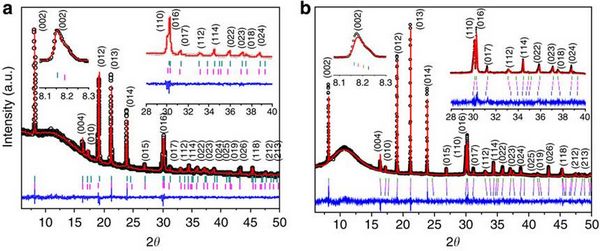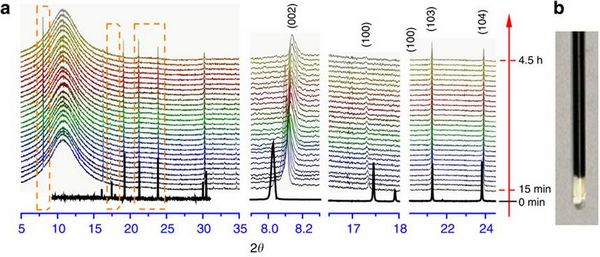Fig.1 Structural changes of P2-Na0.66[Li0.22Ti0.78]O2 during electrochemical insertion/desorption: in situ XRD pattern of synchrotron radiation Fig. 2 Ex-situ XRD pattern of P2-Na0.66[Li0.22Ti0.78]O2 material discharged to 0.4 V. Refined (a) and chemically sodiumized XRD patterns. (b) Figure 3. Structural changes of P2-Na0.66[Li0.22Ti0.78]O2 during chemical sodiumization: in situ XRD pattern of synchrotron radiation Room temperature sodium ion batteries and lithium ion batteries have similar energy storage mechanisms, but sodium is rich in resources and raw material costs are low. Room temperature sodium ion batteries show great potential in the large-scale energy storage of renewable energy and smart grid construction. At present, the anode materials of sodium ion batteries that have been studied mainly include carbon materials, transition metal oxides, alloy materials, and phosphates. Amorphous hard carbon is currently reported as the best overall performance material, but its sodium storage potential close to 0V, it is easy to cause the deposition of metal sodium, bringing security risks. However, although the capacity of Na2Ti3O7 in oxide materials is relatively high, the Na2Ti3O7 has a relatively low sodium storage potential, low efficiency in the first week, and unstable cycling; Li4Ti5O12 as a negative electrode material for sodium-ion batteries still contains a large amount of lithium. Recently, the research group of the Institute of Physics, Chinese Academy of Sciences/Beijing National Laboratory for Condensed Matter Physics (CPC) Li Wei and others have designed a new type of sodium based on the understanding of the mechanism of Li4Ti5O12 sodium incorporation in spinel structures. The ion battery has a layered structure of zero-strain negative electrode material P2-Na0.66[Li0.22Ti0.78]O2. It is predicted by first-principle calculation that the material can be stably present and that only 0.21% of the volume deformation of the sodium during insertion and extraction is found. , And the introduction of lithium contributes to sodium ion transport, further reducing the sodium ion diffusion activation energy. The topics were combined into this material and tested for electrochemical performance. Structural analysis shows that the material is P2 layered oxide, space group P63/mmc, Li\Ti accounts for transition metal sites, sodium accounts for two positions between alkali metal layers, and forms a triangular prism structure with upper and lower oxygen; material particles Sizes are between 10-15 microns. The material shows a reversible capacity of about 116 mAh/g at C/10 rate, corresponding to 0.34 Na insertions and removals, and a capacity retention rate of 88% after 200 cycles; the average sodium storage voltage is 0.75V, which is much higher than that of metals. The deposition potential of sodium; charge-discharge curve is ramp-shaped, may be a single-phase reaction, different from the common multi-phase reaction mechanism of layered P2 phase oxides; at the same time, the capacity retention rate is 75% after cycling for 1200 weeks at 2C magnification. Extremely stable cycle performance; when the anode material is assembled with a vanadium sodium phosphate/carbon composite positive electrode into a full battery, the average working voltage is 2.5V, showing good cycle and rate performance. The apparent diffusion coefficient of Na+ ion at room temperature is about 1×10-10 cm 2 /s, which is in good agreement with the calculated results and is equivalent to the diffusion coefficient of Li+ ion-implanted graphite. The researchers used the in-situ XRD technique of the BL14B station of Shanghai Light Source to conduct an in-depth study of the evolution of the material structure during the insertion/deintercalation process. The reaction mechanism of multiple phase transitions occurs during the insertion/separation reaction of conventional P2 laminates. The P2 laminates of lithium-doped transition metal layers exhibit an approximately single-phase behavior during the insertion/desorption process. 1 is an in-situ XRD pattern during charge and discharge. The accurate determination of the structure of the discharge state of the material (completely sodium-incorporated state) further proves that the material still maintains the P2 layered structure, and the volume change before and after the insertion of sodium is only 0.77%, which is approximately zero strain, which also explains why the material shows extreme Stable cycle performance. In order to avoid the possibility that the sample may be exposed to air during the preparation of electrochemical ex-situ tests, which leads to Ti3+ oxidation, and chemical sodium in situ XRD techniques are also used, the results also indicate that the material maintains the P2 layered structure during sodium insertion, which is sodium. Changes in the structure of the embedded/extracted material provide strong evidence. The specific results are shown in Figures 2 and 3. The results of relevant research are published in the recent Nature Communications (4, 2365, doi: 10.1038/ncomms3365 (2013)).
Hex Nut is a kind of nut, which is screwed together with Bolt or screw for fastening. All manufacturing machinery must use a kind of component. According to different materials, it can be divided into carbon steel, stainless steel, non-ferrous metal (such as copper) and other types.we have the perfect after-sales service and technical support.
Nuts Screws,Hexagon K Nuts,Open End Rivet Nut,Carbon Steel Flat Head Rivet Nut Suzhou Gubao Screws Co.,Ltd. , https://www.hongyiscrew.com

